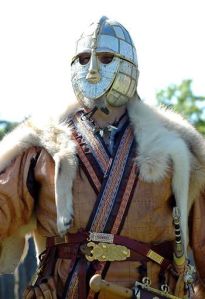By Periklis Deligiannis

A Late Roman helmet rather of Persian distant origin (design), decorated with semi-gemstones. The Romano-Britons inherited this type together with the rest of the Roman weaponry and military organization.
.

In the 5th-6th centuries AD, the Anglo-Saxons brought to Britain many elements of the eastern Scandinavian Proto-Vendel and Vendel cultures, several of which are obvious on their arms and armor, i.e. on their helmets (Sutton Hoo burial, etc.), daggers, swords etc (reconstruction of an Anglo-Saxon warlord wearing a Sutton Hoo-type helmet, by the Historical Association Wulfheodenas ).
.
In 407 AD the Romans withdrew their last regular troops from the British provinces. The independent Romano-Britons had to fight hard against the Pict, Irish and Anglo-Saxon barbarians who were besieging their territory. Former Roman Britain was gradually divided into autonomous ‘principalities’ led by warlords. However they tried to keep united their “British kingdom” as they considered their common territory, and mainly to repel the invading Anglo-Saxons who had conquered the Southeast, advancing headlong. It seems that the Britons in order to maintain their unity, elected a military commander (Dux) as a senior politico-military leader, who led the operations against the invaders and took care on preventing infighting. A sequence of inspired Dukes (Voteporix, Vortigern, Ambrosius Aurelianus) led the British resistance. Those who accept Arthur’s historicity usually consider him as one of these Dukes (a theory consider him Aurelianus’ son).
The Briton literary tradition and the archaeological evidence, mainly the Saxon burials, denote that the Anglo-Saxon invasion was halted on the verge of the 5th-6th centuries AD. Many scholars believe that the military action of the legendary king Arthur was the main ‘factor’ for the repulse of the newcomers. However, his historicity is strongly and justifiably disputed. In this series of articles I will deal with some additional literary, archaeological and historical evidence concerning his historicity.
.
The literary sources on Arthur
The first literary reference to Arthur appears in the Northern Briton epic “Y Goddodin” (“the Votadini” around AD 600) which recounts an attempt of the Votadini people (Celtic Goddodin) of the modern Scottish Lowlands and their allies, to check the advance of the Angles. Some scholars believe that the mention of Arthur in this epic was added later. The first ‘secure’ reference to the legendary commander comes from Nennius in his “History of the Britons” (“Historia Britonnum”, end of 8th century). Nennius’ work was based mostly on the local Briton tradition. Nennius describes the legendary figure as a warlord who repelled the barbarians around the 5th-6th centuries. This was followed shortly after by another reference of Arthur in the “Annales Cambriae” (9th c.). But the author, who developed most of all Arthur’s renowned image as a just and powerful warrior-king, was the Archdeacon of Oxford Geoffrey of Monmouth in his largely mythical “History of the Kings of Britain” (“Historia Regum Britanniae”, AD 1133). Geoffrey relied heavily on the two aforementioned works, and possibly on the local oral tradition. In France, the late medieval chronicler Chretien de Troyes holds an analogous contribution to the Arthurian legend. The later writers of the Arthurian epic circle are based on the works of the last two authors (mostly on Geoffrey’s work and less on Chretien’s) going on to the enrichment of the epic with elements belonging mainly to the Late Middle Ages, such as the Round Table, the quest for the Holy Grail, etc.
More















